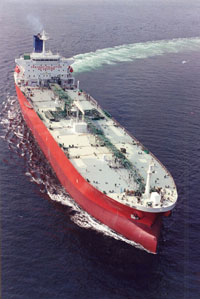
Peter Chayson, Berlian Laju GM, has a keen eye on the chemical tanker market. Photo by Joanne Looi.
”A FINANCIAL CRISIS as severe as the current one shows how stable freight rates for chemicals are,” said Berlian Laju Tanker’s general manager, Peter Chayson, at a Financial PR road show recently.
Based in Indonesia, Berlian Laju is the world’s third-largest chemical tanker operator.
Other than 63 chemical tankers, it also has 13 oil tankers, and 13 LNG carriers.
Not only that, it has committed capital expenditure of US$474 million over the next 4 years to expand its fleet to 104 tankers by 2012.
In this time of severe vessel supply glut plus credit crunch, is such an aggressive fleet expansion foolhardy, or this there a story that some of us are missing?
Why tanker freight rates are stable
Year-to-date spot chemical freight rates have hovered between US$55 to US$70 a ton, not very different from the US$65 five-year average.
In comparison, the Baltic Dry Index has swung wildly from less than 2,000 points to over 10,000 points over the same period.
Chemical freight rates are expected to decline by 4-8% in 2009 and start rising in 2010, according to Drewry Shipping Consultants.
Vessel supply in check

CIMB downgraded the stock after its rights issue announcement.
According to Peter, the pipeline of tanker supply has been kept in check, unlike bulk and container shipping where there is severe vessel supply glut.
Newbuilding orderbook for tankers, currently 35% of current fleet size, is relatively small.
For chemical tankers, orderbook is even smaller at 21% of current fleet size, with 15% of the existing fleet 25 years or older in the next 3 years.
In comparison, the global orderbook for container vessels is over 50% of fleet size while orders for large bulk carriers like capsize or very large ore carriers (VLOC) are over 100% of the existing fleet.
Part of the disparity has to do with the number of yards with expertise in building the 3 vessel types.
Bulk cargo carriers are the easiest to build, but not many yards build tankers due to the complexities involved.
About 80% of Berlian Laju’s fleet of chemical tankers is equipped with cargo tanks built from stainless steel, which can carry all types of chemical products, including aggressive acid cargoes such as sulfuric and phosphoric acid.
Stainless steel cargo tanks are superior to coated tanks. For example, epoxy coated tanks may carry palm oil, but can carry neither acid nor methanol even though the later 2 are huge cargo markets. Zinc coated tanks may carry methanol, but not acid nor palm oil.
Regulations restrict vessel supply

Berlian Laju's tanker.
A second tanker supply dampener is that the IMO regulation for mandatory scrapping of single-hull tankers plying international waters comes into effect next year.
Considering that almost 20% of the existing global fleet is single hull, excess tanker supply over replaced vessels is even smaller.
Thirdly, tanker freight rates are supported as oil majors are willing to pay to ensure safety procedures adopted for the chartered vessel.
For example, the IMO regulation may restrict maximum vessel age to 25 but BP would only use vessels of 15-20 years old or less.
Indonesia’s cabotage rule
Indonesia comprises of a cluster of as many as 17,500 islands, of which about 6,000 are inhabited, and relies heavily on transshipment vessels.
From next year onwards, only vessels with Indonesian flag are allowed to operate in its waters. In fact, the cabotage rule was already implemented from this year for non-oil/gas liquids.
The shift in demand from foreign to Indon-flagged vessels will benefit Berlian Laju, as the other major chemical tanker operators are either European or Japanese.
About 10% of Berlian Laju's fleet bear Indon flags.
Bargaining power
Finally, a handful of major players (Berlian Laju is one) dominate the niche chemical tanker market, availing some monopolistic power to the tanker operators in negotiation of freight rates.
Only 170 million to 180 million tons of chemicals are traded annually, compared to 2.5 million to 3 million tons a year of crude oil.
”We like the chemical segment as it fits our strategic objective of consistent cash flow growth,” he concluded.
Recent story: PRECIOUS SHIPPING boss: "BDI could crash quickly"

